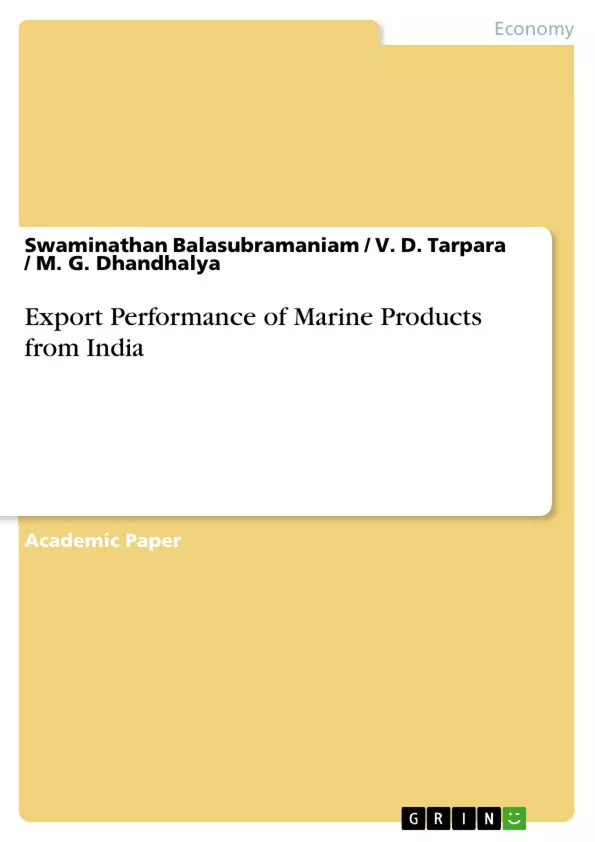Marine products industry alone has a share of at least 6 per cent in world exports in which India is the fourth largest exporting country after China, Peru and Japan. In fact, out of 7.85 million tonnes (mt) of overall fish production of India, roughly 43 per cent is contributed by the marine sector though it turns out to be less than half to that of India’s major competitors in fish trade. Marine products exports play a pivotal role in Indian economy in terms of employment and income generation besides valuable foreign exchange earnings. They have created a huge demand in international trade and are acclaimed to be one of the fastest moving commodities in the world food market.
China, Thailand, Vietnam, Chile, Taiwan, Indonesia, India, Peru and South Korea are the main sea-food exporters comprising more than 60 per cent of trade value of marine products. In general, 38 per cent (live weight equivalent) of total fisheries product is traded internationally. But with only 20 per cent of its total fish production entering world trade, Indian seafood exports are far below than the global average.
Fortunately, India’s vast coastline of 8,129 km stretching almost two-thirds of the country and encompassing an exclusive economic zone (EEZ) of more than 2.2 million sq. km. offers sufficient surplus of fish and fishery products, which is currently under-exploited. As of 2015-16, marine products with export earnings crossing Rs. 30,420 crores constituted 21 per cent of the total agricultural exports from India which in turn was 1.2 per cent of its gross domestic product (GDP) and 4.72 per cent of its Agri-GDP.
Table of Contents
- Introduction
- Review of Literature
- Methodology and data sources
- Pre-WTO phase
- Transition-WTO phase
- Post-WTO phase
- Analytical tools
- Compound growth rate
- Instability Analysis
- Markov Chain Approach
- Goodness of fit test
- Prediction of exports from India
- Results and Discussion
- Possible factors for growth erosion
- Market-wise instability
- Commodity-wise growth
- Commodity-wise instability
- Trade composition
- Destination of trade
- Direction of trade
- Export market projections
- Conclusion
- Recommendation for policy makers
- References
Objectives and Key Themes
This study aims to examine the growth, instability, destination pattern and trade direction of Indian marine products exports before and after the WTO regime. It aims to understand the growth pattern in the exports of fresh and dried marine products from India, measure variability in marine products exports, analyze the direction of trade and structural changes in marine products exports, and predict future marine products exports from India.
- Growth and instability of India's marine products exports
- Impact of the WTO regime on Indian marine products exports
- Destination and direction of trade in marine products from India
- Factors influencing the export performance of Indian marine products
- Predictions for future marine products exports from India
Chapter Summaries
The introduction chapter establishes the importance of marine products exports to the Indian economy, highlighting its contribution to employment, income generation, and foreign exchange earnings. The review of literature section discusses existing research on the Indian marine sector, including challenges faced by the industry such as declining shrimp catches, overcapitalization, price instability, and decreasing profitability. The methodology and data sources chapter describes the data used in the study, spanning a period of 30 years from 1986 to 2015, and categorizes the study period into pre-WTO, transition-WTO, and post-WTO phases. The subsequent chapters delve into analytical tools used to assess the growth, instability, and trade patterns of Indian marine products exports.
Keywords
This study examines the export performance of marine products from India, focusing on factors such as growth, instability, trade composition, destination of trade, and direction of trade. The analysis considers the impact of the WTO regime on the industry, exploring key themes like compliance with sanitary and phyto-sanitary standards, price competitiveness, and export market projections. The study draws on data from the Marine Products Export Development Authority (MPEDA) to analyze the export performance of various marine products, including shrimp, fish, and other seafood items.
- Quote paper
- Swaminathan Balasubramaniam (Author), V. D. Tarpara (Author), M. G. Dhandhalya (Author), 2017, Export Performance of Marine Products from India, Munich, GRIN Verlag, https://www.grin.com/document/424798



